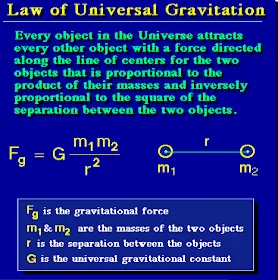9th Physics Gravitation
Class 9th Science -Physics
ICSE/ CBSE Notes-
For more Notes click this link https://cbsenotesallsub.blogspot.com/
Gravitation
- Gravity Gravity is the force by which a planet or other body draws objects toward its center.
- The force of gravity keeps all of the planets in orbit around the sun.

some important points-
- gravity also called gravitation in mechanics, the universal force of attraction acting between all matter.
- It is the weakest force in nature.
- At Earth’s surface the acceleration of gravity is about 9.8 m/S2
- The Moon's surface gravity is about 1/6th as powerful or about 1.6 meters per second per second.
- The Moon's surface gravity is weaker than Earth.
- A body's surface gravity is proportional to its mass, and inversely proportional to the square of its radius.
- Gravitation or just gravity is the force of attraction between any two bodies.
- All the objects in the universe attract each other with a certain amount of force, but in most of the cases, the force is too weak.
For more Notes click this link https://cbsenotesallsub.blogspot.com/
Universal law of Gravitation
According to universal Law of Gravitation, every body in the universe attracts every other body with a force. this force is called gravitational force.
- The force between two bodies is directly proportional to the product of their Masses and inversely proportional to the square of the distance between them.

Note-
- If we double the distance between two bodies , The gravitational force become one-forth.
- If we double the both mass of the body then the gravitational force become four times
- If we half the distance between two bodies then the gravitational force becomes four times
- If we half the both mass of the body then gravitational force becomes one -fourth times.
For more Notes click this link https://cbsenotesallsub.blogspot.com/
Unit of Gravitational constant 'G'
- According to universal law of gravitation the gravitational force
F = Gm1m2/r2
Hence Unit of ' F ' is Newton
unit of m1 and m2 is kg
unit of r is meter
then unit of gravitational constant G is Nm2/kg2
- The value of gravitational constant G = 6.67 × 10-11 Newtons m2kg-2
Example-1 What is the magnitude of the gravitational force between the earth and a 1 kg object on its surface. If Mass of the earth is 6 x 1024 kg and radius of the earth is 6.4 x 106 m
and G = 6.67 × 10-11 Newtons m2kg-2
Solution-

For more Notes click this link https://cbsenotesallsub.blogspot.com/
Gravitational Force hold the solar system together
- All satellites move in circular orbit around the planets due to centripetal force.
- Centripetal force is that force which moves the object in circular path.
- Centripetal force is provided by the gravitational force of the sun.
- Sun is a star and Earth is a planet both have very large mass so they exert very large force ti each other.
NOTE-
- Due to gravitational force between the sun and earth which keeps the earth in uniform circular motion around the sun .
- The moon moves around the earth due to gravitational force exerted by the earth.
- The water level of sea rise and fall due to tidal wave which is developed by gravitational force.
Kepler's Laws of Planetary Motion
- These laws are given by JOHANNES Kepler .
- J. Kepler gave three laws of planetary motion.
1-Kepler's First Laws
According to Kepler's First Laws of motion the planets move in elliptical orbits around the sun ,with the sun at one of the two foci of the elliptical orbit.
2-Kepler's second Law
According to Kepler's second Law , each planet revolves around the sun in such a way that the line joining the planet to the sun sweeps over equal areas in equal interval of time.
- A planet does not move with constant speed around the sun
- The speed is greater when the planet near the sun
- The speed is less when the planet is farther away from the sun.
According to Kepler's third Law, the cube of the mean distance of a planet form the sun is directly proportional to the square of time it takes to move around the sun






Sir class 9 ki math ka solution Chapter 6 ka
ReplyDelete